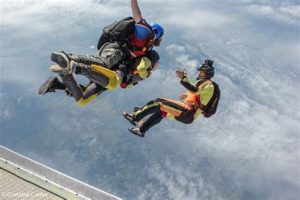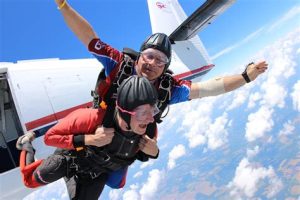Table of Contents
Tandem skydiving and skydiving are two different ways to experience the thrill of jumping out of a plane. Tandem skydiving involves being securely attached to an experienced instructor, while skydiving refers to solo jumps. Both offer an adrenaline rush and breathtaking views, but tandem skydiving is ideal for beginners or those seeking a more controlled experience, whereas skydiving allows for greater freedom and independence in the air. Choose the option that suits your comfort level and desire for adventure!
Tandem skydiving and skydiving are two thrilling activities that allow individuals to experience the exhilarating rush of freefall while enjoying breathtaking views from above. However, despite their similarities, these two forms of skydiving differ in several key aspects. By understanding these differences, individuals can make an informed decision about which type of skydiving experience suits them best.
The Difference Between Tandem Skydiving And Skydiving
Skydiving is an exhilarating sport that allows individuals to experience the thrill of freefalling through the sky. There are two main types of skydiving: tandem skydiving and solo skydiving. While both involve jumping out of an aircraft, there are some key differences between the two experiences. In this article, we will explore the dissimilarities between tandem skydiving and solo skydiving.
Tandem Skydiving
Tandem skydiving is the most popular form of skydiving for beginners and those who want to experience the thrill without having to undergo extensive training. During a tandem skydive, the participant is securely attached to an experienced instructor with a specially designed harness. This allows the instructor to take care of all the technical aspects of the jump, leaving the participant free to enjoy the experience.
Solo Skydiving
Solo skydiving, also known as accelerated freefall (AFF), is the next step for those who want to pursue skydiving beyond the tandem level. Unlike tandem skydiving, solo skydiving requires individuals to complete a comprehensive training program before they can jump alone. This training typically includes classroom instruction, simulator sessions, and multiple jumps with instructors.
Experience Level
One of the main differences between tandem skydiving and solo skydiving is the experience level required. Tandem skydiving does not require any prior experience or training, making it accessible to virtually anyone who meets the physical requirements. On the other hand, solo skydiving necessitates participants to complete a minimum number of jumps and pass certain proficiency tests before they can jump without an instructor.
Freefall Time
The duration of the freefall is another difference between tandem skydiving and solo skydiving. In tandem skydiving, the participant experiences a longer freefall time as the instructor controls the descent. This allows the participant to fully immerse themselves in the adrenaline-pumping sensation of freefall. In solo skydiving, the freefall time is typically shorter as the focus is on skill development and canopy control.
Control of the Parachute
In tandem skydiving, the instructor is responsible for deploying and controlling the parachute. This allows the participant to relax and enjoy the ride without having to worry about operating the equipment. In contrast, solo skydivers have the opportunity to deploy and control their own parachutes. They must demonstrate their ability to handle emergency situations and safely land their parachutes during their training.
Safety Measures
Both tandem skydiving and solo skydiving prioritize safety. In tandem skydiving, the participant relies on the expertise of the instructor to ensure a safe and enjoyable experience. The instructor is responsible for checking all equipment, making the necessary adjustments, and deploying the parachute at the appropriate altitude. In solo skydiving, participants are trained extensively in safety procedures and emergency protocols to handle any unexpected situations that may arise.
Cost and Accessibility
Tandem skydiving is generally more affordable compared to solo skydiving. This is because participants do not have to invest in extensive training or purchase their own equipment. Tandem skydiving is also more accessible as it does not require the same level of commitment and time investment as solo skydiving. However, for individuals who are passionate about skydiving and wish to pursue it as a hobby or a career, solo skydiving provides the opportunity for personal growth and skill development.
The Adrenaline Rush
Both tandem skydiving and solo skydiving offer an unparalleled adrenaline rush. The sensation of stepping out of an aircraft and freefalling through the sky at high speeds is an experience like no other. Whether you choose tandem skydiving or solo skydiving, you can expect an adrenaline-fueled adventure that will leave you with memories to last a lifetime.
In conclusion, tandem skydiving and solo skydiving differ in terms of experience level, freefall time, control of the parachute, safety measures, cost, and accessibility. While tandem skydiving is ideal for beginners and those seeking an exciting one-time experience, solo skydiving provides the opportunity for skill development and further exploration of the sport. Whichever option you choose, be prepared for an unforgettable adventure that will push your limits and give you a new perspective on life from above.
Difference Between Tandem Skydiving and Skydiving: A Comprehensive Guide
1. Definition and Introduction
Tandem skydiving involves jumping out of an aircraft harnessed to an experienced instructor, while traditional skydiving refers to solo jumps performed by trained individuals. Both tandem skydiving and skydiving provide the thrill of freefall and the experience of descending from a high altitude.
2. Training and Requirements
Tandem skydiving requires minimal training, typically consisting of a safety briefing and instructions on body positioning during the dive. Skydiving, on the other hand, demands extensive training, including ground instruction, proper body control techniques, and emergency procedures, before being certified to jump solo.
3. Level of Responsibility
In tandem skydiving, the instructor is primarily responsible for the jump, providing assistance with equipment and ensuring a safe landing. In solo skydiving, the individual diver assumes full responsibility for their own safety, utilizing their training to control the parachute and safely land.
4. Experience and Control
Tandem skydiving offers a more relaxed experience, allowing participants to enjoy a thrilling freefall without having to worry about controlling the parachute. Skydiving provides a greater sense of control and self-reliance, as divers have the opportunity to learn and execute more advanced maneuvers during the descent.
5. Accessibility
Tandem skydiving is more accessible to beginners and people with physical limitations, as the instructor takes on the primary responsibility, while the participant can simply enjoy the experience. Skydiving, due to the extensive training requirements, may appeal more to individuals seeking a more intimate immersion into the sport and who are willing to commit the necessary time and effort.
6. Pricing and Costs
Tandem skydiving generally has a lower price point compared to skydiving, making it more affordable for those looking for an introduction to the sport or a one-time adventure. Skydiving entails higher costs due to the comprehensive training and equipment required, but it offers the opportunity to pursue solo jumps and advance to more challenging disciplines within skydiving.
7. Certification and Progression
Tandem skydiving does not provide any certification but can serve as a stepping stone to skydiving courses for those interested in pursuing advanced training. Skydiving enables individuals to progress through different stages of certification, granting them the ability to participate in more complex dives and eventually becoming qualified skydivers.
8. Overall Experience
Tandem skydiving offers a unique, shared experience where participants can bond with their instructor during the jump, enjoying the adventure side by side. Skydiving, being a solo activity, provides a sense of independence and personal achievement, as divers conquer their fears and master the art of skydiving.
Remember, always prioritize safety and adhere to the instructions provided by your instructors or certified skydiving professionals.
Point of View: Difference Between Tandem Skydiving and Skydiving
Tone: Informative, objective
Voice: Authoritative
-
Tandem Skydiving:
- Tandem skydiving involves jumping out of an aircraft while harnessed to a professional skydiver.
- In this type of skydiving, the instructor takes care of all the technical aspects, such as equipment checks and parachute deployment.
- It is a popular choice for beginners or those who want to experience skydiving without extensive training.
- The instructor guides the tandem student throughout the whole process, ensuring safety and a smooth landing.
- Participants can enjoy the breathtaking views and the adrenaline rush without worrying about the technicalities.
- It offers a great opportunity to try skydiving without the commitment of becoming a licensed skydiver.
-
Skydiving:
- Skydiving refers to the act of jumping out of an aircraft alone or with a group, using a parachute to descend safely to the ground.
- Unlike tandem skydiving, skydivers need to undergo comprehensive training and obtain a license before jumping solo.
- Training includes learning about equipment, safety procedures, body positioning, and parachute control.
- During a skydive, the individual is responsible for deploying their own parachute and guiding themselves to a safe landing.
- Skydiving offers more freedom and control over the entire experience, as participants get to plan and execute their own jumps.
- It provides a thrilling challenge for those who seek a deeper understanding of the sport and wish to become certified skydivers.
In summary, tandem skydiving is a convenient option for beginners or individuals who want to experience the thrill of skydiving with minimal training and responsibility. On the other hand, skydiving requires extensive training and certification, offering participants the freedom and control to plan and execute their own jumps. Both options provide an exhilarating experience and breathtaking views, catering to different levels of interest and commitment in the sport of skydiving.
Thank you for visiting our blog and taking the time to learn about the thrilling world of skydiving! In this article, we explored the key differences between tandem skydiving and solo skydiving. Whether you are a beginner considering your first jump or an experienced skydiver looking for a new challenge, understanding these distinctions is crucial. So, let’s recap what we’ve discovered.
Firstly, tandem skydiving is an excellent choice for beginners who want to experience the thrill of freefall without the added responsibility of operating the parachute. In this type of jump, you are securely harnessed to an experienced instructor who will guide you through every step of the process. This allows you to fully enjoy the adrenaline rush and breathtaking views while feeling confident that you are in safe hands. Moreover, no prior training is required for tandem skydiving, making it accessible to anyone who meets the physical requirements.
On the other hand, solo skydiving, also known as static line or accelerated freefall (AFF) skydiving, offers a more independent and challenging experience. With solo skydiving, you undergo comprehensive training to develop the necessary skills for a safe jump. During your first few jumps, a static line or automatic activation device (AAD) will automatically deploy your parachute at a predetermined altitude. As you progress in your training, you will transition to freefall jumps, where you have full control of your own canopy deployment. This type of skydiving requires dedication, discipline, and a willingness to invest time and effort into learning the necessary skills.
In summary, the main difference between tandem skydiving and solo skydiving lies in the level of independence and responsibility. Tandem skydiving is a fantastic choice for beginners looking for an adrenaline-packed experience with minimal training, guided by an experienced instructor. On the other hand, solo skydiving offers a more challenging and independent experience, where you have full control over your own parachute deployment. Whichever option you choose, both tandem and solo skydiving promise an unforgettable adventure that will leave you with memories to last a lifetime.
We hope this article has provided you with valuable insights into the differences between tandem skydiving and solo skydiving. If you have any further questions or would like to share your own skydiving experiences, please feel free to leave a comment below. Safe travels, and may your skydiving dreams soar to new heights!
Video Difference Between Tandem Skydiving And Skydiving
Difference Between Tandem Skydiving And Skydiving
When it comes to the exhilarating world of skydiving, you may wonder about the difference between tandem skydiving and regular skydiving. Here are some commonly asked questions that can help clarify the distinctions:
1. What is tandem skydiving?
Tandem skydiving is a type of skydiving where you are attached to an experienced instructor who controls the parachute and ensures your safety throughout the entire jump. It is an ideal option for first-time skydivers or those who prefer a more controlled and guided experience.
2. How does it differ from regular skydiving?
In regular skydiving, also known as solo skydiving or sport skydiving, individuals receive extensive training and certification to jump alone. Unlike tandem skydiving, you will be responsible for deploying and controlling your own parachute during the descent. Regular skydiving offers a greater sense of independence and freedom in the air.
3. Is tandem skydiving safer than regular skydiving?
Tandem skydiving is generally considered to be safer than regular skydiving because you have an experienced instructor with you throughout the jump who handles all the technical aspects. However, both types of skydiving involve inherent risks, and it is essential to follow all safety protocols and instructions provided by the professionals.
4. Can beginners try regular skydiving without prior experience?
No, beginners cannot try regular skydiving without proper training and certification. It is crucial to undergo a comprehensive training program, usually referred to as Accelerated Freefall (AFF), which includes ground instruction and multiple jumps with instructors before being allowed to skydive solo.
5. Which type of skydiving is recommended for beginners?
Tandem skydiving is highly recommended for beginners as it provides a safe and controlled environment while still allowing you to experience the thrill of freefall. It requires minimal training and allows you to enjoy the breathtaking views without having to worry about deploying the parachute or other technicalities.
Remember, whether you choose tandem skydiving or regular skydiving, always follow the instructions provided by the professionals and adhere to the safety guidelines to ensure a memorable and safe skydiving experience.






